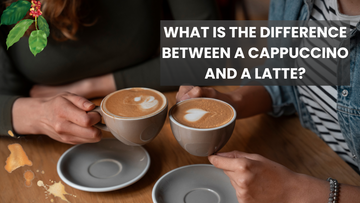Are There More Flavors of Coffee or Tea?

Some battles are legendary—morning people vs. night owls, crunchy vs. smooth peanut butter, and, of course, a variety of coffee and tea flavors. One is bold and energizing; the other is soothing and sophisticated.
But which one truly wins the flavor comparison: coffee or tea? Is coffee just fancy bean water with different levels of intensity? Or does tea secretly dominate with its endless flavors and herbal magic?
Let’s get into the battle of flavors of coffee and tea because choosing a favorite might be more complicated than picking a Netflix show on a Friday night!
Understanding the Flavor Profiles of Coffee and Tea
The growing conditions and processing methods influence the flavors of coffee and tea, as well as the way they are brewed. Although both beverages originate from plants, their paths from farm to cup create unique and varied flavor profiles for coffee and tea.
How Coffee Develops Flavor?
The types of coffee flavors begin with the environment in which the beans grow. Factors like altitude, soil type, and climate influence taste—higher elevations often produce beans with brighter acidity and complex fruity notes. After harvesting, the processing method impacts sweetness and body, playing a key role in coffee flavoring.
Roasting is the biggest game-changer in coffee flavor, transforming raw beans into rich, aromatic brews.
· Light Roasts – Retain the bean’s natural character, preserving fruity, floral, and citrusy notes with bright acidity.
· Medium Roasts – Strike a balance between acidity and body, highlighting nutty, chocolatey, caramel-like flavors.
· Dark Roasts – Develop bold and intense flavors, bringing out smoky, caramelized, and slightly bitter tones with a fuller body.
How Does Tea Develop Flavor?
Just like coffee, the variety of tea flavors is influenced by the location and methods used to cultivate the tea leaves. Factors such as soil, climate, and altitude affect the taste, but the processing of the leaves is also essential. What is the most significant step? Fermentation (oxidation) determines whether a tea becomes green, oolong, or black.
Beyond these, tea blends and varieties introduce unique tastes by mixing different leaves, herbs, and spices. The herbal tea flavor range offers diverse profiles, from floral chamomile to spicy ginger and refreshing peppermint.
Exploring the Different Types and Flavors of Tea
The different tea types and flavors reveal a rich and diverse world of beverages. From classic black tea to refreshing herbal infusions, various tea flavors offer something for every taste preference.
The main tea flavor categories, herbal, green, black, and more, each have unique characteristics and health benefits.
1. Green Tea: Unoxidized and rich in antioxidants, green tea has a mild astringency and a vegetal, grassy taste, making it one of the most popular tea flavors worldwide.
2. Oolong Tea: Partially oxidized, it delivers floral, fruity, and earthy notes that change with multiple infusions, showcasing unique tea flavor combinations with each brew.
3. Black Tea: Fully oxidized and bold, black tea is often enjoyed with milk or sugar. It is known for its robust, malty, and smoky flavors, making it a staple among herbal, green, black, and other tea flavors.
4. Herbal Tea: Naturally caffeine-free, herbal tea flavors range from calming chamomile to refreshing peppermint and rooibos, offering fruity tea blends and floral infusions.
5. White Tea: Minimally processed and delicate, white tea has mild, sweet, and floral notes, making it a connoisseur’s favorite among tea types and flavors.
Popular Tea Flavors and Unique Combinations
· Jasmine Tea: Fragrant and floral, often infused with real jasmine blossoms.
· Hibiscus Tea: A tart, cranberry-like taste with a deep red hue, popular in fruity tea blends.
· Chai Tea: A chai tea flavor has a warming mix of cinnamon, cardamom, ginger, and cloves, a staple in popular tea flavors worldwide.
· Earl Grey Tea: Black tea infused with bergamot oil, offering citrusy and floral notes.
A Look at the Best and Most Unique Coffee Flavors

Coffee is more than just a morning ritual; it’s an experience of rich aromas, bold tastes, and endless possibilities. From classic favorites to adventurous blends, the world of best-flavored coffee offers something for every palate.
If you want to enjoy smooth vanilla or bold whiskey-infused brews, there’s a flavor waiting to be explored.
Popular Flavored Coffee Beans
1. Caramel Coffee: A sweet and buttery delight, perfect for those who love a dessert-like experience.
2. Vanilla Coffee: A smooth, creamy classic that accentuates the natural warmth of coffee.
3. Hazelnut Coffee: A nutty and aromatic choice, blending beautifully with black and creamy coffee.
4. Mocha Coffee: The perfect mix of coffee and chocolate, making every sip indulgent.
Unique Flavors of Coffee Worth Trying
· Buttered Coffee: A creamy and rich energy booster known as bulletproof coffee.
· Whiskey-Infused Coffee: These flavored coffee beans carry the smoky, caramelized notes of whiskey—without the alcohol.
· Pumpkin Spice Latte: A seasonal favorite featuring warm spiced coffee varieties like cinnamon, nutmeg, and cloves.
· Lavender Coffee: Floral and calming, this unique blend brings a tea-like quality to coffe
Unique Flavors of Coffee Worth Trying
· Buttered Coffee: A creamy and rich energy booster known as bulletproof coffee.
· Whiskey-Infused Coffee: These flavored coffee beans carry the smoky, caramelized notes of whiskey—without the alcohol.
· Pumpkin Spice Latte: A seasonal favorite featuring warm spiced coffee varieties like cinnamon, nutmeg, and cloves.
· Lavender Coffee: Floral and calming, this unique blend brings a tea-like quality to coffe
Are There More Flavors of Coffee or Tea?
Both coffee and tea boast an incredible range of flavors, but which one truly offers more variety?
Also Read: How is coffee roasted to create different flavors?
Variety of Coffee Flavors
Factors like bean origin, roasting, and brewing methods shape the taste of coffee. The coffee flavors range from rich chocolatey and nutty notes to bright, fruity, and floral undertones. Some popular coffee and tea flavors include:
· Classic Coffee Flavors: caramel, mocha, hazelnut, and vanilla.
· Exotic Coffee and Tea Options: whiskey-infused coffee, buttered coffee, and even lavender-infused espresso.
Variety of Tea Flavors
Tea, on the other hand, develops its flavors through oxidation and processing. Tea flavors span earthy, grassy, floral, and smoky notes. Some well-known flavors include:
· Traditional Teas: – Green tea (vegetal and fresh), black tea (bold and malty), oolong tea (fruity and floral).
· Herbal Infusions: Chamomile (soothing and reminiscent of honey), hibiscus (tart and reminiscent of berries), and rooibos (sweet and nutty)
Coffee vs Tea Flavors: Which One Wins?
While coffee is known for its deep, roasted complexity, tea offers a more delicate and evolving range of tastes. So, is tea or coffee better in terms of variety? It depends on your preference! If you love bold, intense flavors, coffee might be your go-to. Tea has the edge if you enjoy a diverse selection of naturally flavored drinks.
Which Has More Caffeine: Coffee or Tea?

If you’ve ever wondered if tea or coffee has more caffeine, you’re not alone! Both drinks provide a much-needed energy boost, but their caffeine content varies based on type, preparation, and serving size.
What Has Higher Caffeine: Coffee or Tea?
Generally, coffee contains more caffeine than tea. A standard cup of brewed coffee has about 95 mg of caffeine, while black tea contains around 40-70 mg per cup. Green tea typically has even less, with about 20-45 mg per cup. However, matcha—made from powdered green tea leaves—can have caffeine levels that are closer to those of coffee
Coffee vs. Tea: Health Benefits Compared
Regarding coffee’s and tea’s health benefits, both beverages offer unique advantages, making the choice between them more than just about taste.
Health Benefits of Coffee
· Boosts Mental Alertness: The high caffeine content in coffee enhances focus and cognitive function.
· Rich in antioxidants: – Coffee is packed with polyphenols, which help fight inflammation and reduce the risk of chronic diseases.
· May Lower Disease Risk: Studies suggest coffee consumption may lower the risk of Parkinson’s, Alzheimer’s, and type 2 diabetes.
Health Benefits of Tea
· Packed with Antioxidants: Tea contains catechins and flavonoids that support heart health and fight free radicals.
· Supports Digestion: Certain teas, like ginger and peppermint, aid digestion and soothe stomach discomfort.
· May Reduce Heart Disease Risk: Regular tea drinkers may experience lower blood pressure and improved heart health
Conclusion
When it comes to the endless battle of coffee and tea flavors, the winner truly depends on your taste preferences. No matter your choice, the real magic lies in savoring every sip.
Why settle for ordinary when you can sip extraordinary? At Brew the Blend, we bring specialty-grade coffee, single-origin delights, and premium teas—all crafted without synthetic flavors or toxic chemicals.
Start your perfect brew today. Shop now and taste the difference!
FAQs
Q: What has more flavor, tea or coffee?
Coffee has a more substantial, bolder taste due to roasting, while tea offers a broader range of delicate flavors influenced by oxidation and fermentation. It depends on personal preference!
Q: How many flavors does coffee have?
Coffee has hundreds of flavor notes, including nutty, chocolatey, fruity, floral, caramel, and smoky, depending on bean type, roast level, and brewing method.
Q: Which is more popular, tea or coffee?
Tea is more consumed, especially in Asia and the UK, but coffee dominates in Western countries like the U.S. and Europe due to its caffeine boost and rich taste.
Q: Is tea more diverse than coffee?
Yes! Tea comes in green, black, white, oolong, and herbal varieties, each with unique flavors influenced by oxidation, fermentation, and ingredients, making it highly diverse.
Q: Does flavored coffee have calories?
Plain coffee has almost zero calories, but flavored coffee with syrups, creamers, or sweeteners can add sugar and calories, depending on the ingredients used.
Q: Is flavored coffee bad for you?
Flavored coffee isn’t bad, but artificial syrups and excessive sugar can cause health issues. Instead, opt for healthier natural coffee flavors like cinnamon, vanilla, or cocoa.
Q: What flavor is chai tea?
Chai tea has a spiced, warm, and slightly sweet flavor with cinnamon, cardamom, ginger, cloves, and black pepper, creating a bold and aromatic taste.
Read More Here:






